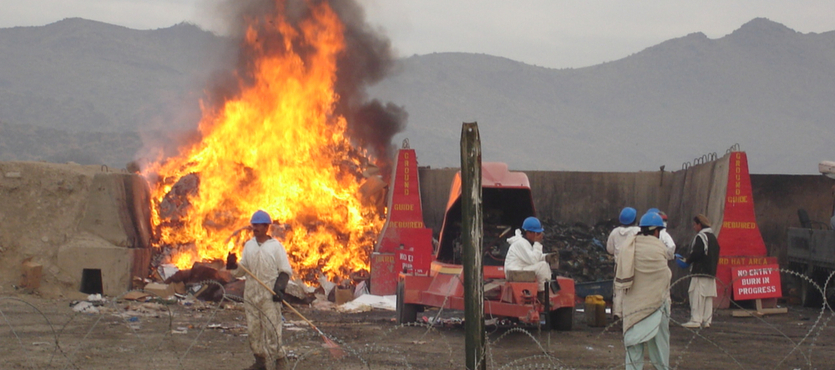A new research center in New Jersey should help Iraq veterans struggling with burn pit-related illnesses get the treatment they need.
Professionals at the new Airborne Hazards and Burn Pits Center of Excellence will conduct research and also create partnerships to help returning War on Terror veterans who were exposed to burn pit smoke in Southwest Asia. Dr. Anays Sotolongo, the Center’s director, said worker will begin by analyzing the information in the VA’s burn pit database. Some 173,000 veterans submitted information. Then, the Center will form “collaborative partnerships with the Department of Defense, with academic partners and others to better understand the spectrum of diseases, health outcomes and treatments,” Dr. Sotolongo said. “We want to serve as a resource for providers seeing veterans all over the country,” he added.
At one point, there were two dozen burn pits in Iraq and over 250 in Afghanistan.
Burn Pits
Many people have compared burn pit illnesses to Agent Orange exposure during the Vietnam War. For many years, the VA denied that the toxic herbicide used to defoliate Southeast Asian jungles was a health hazard. Now, the VA says the same thing about burn pits. Fortunately, the Department of Labor, which administers the Defense Base Act, has not taken a similar stance. More on that below.
As American armed forces advanced quickly across Iraq in 2003, waste disposal was the last thing on anyone’s mind. The DoD has long authorized small burn pits as a temporary measure in these situations. In this case, “temporary” turned out to be almost a decade, and “small” turned out to be pits almost as big as football fields.
As the name implies, a burn pit is a huge hole in the ground that is filled with all the refuse from the military base or other location. That includes things like:
- Rubber tires,
- Discarded metal vehicle parts,
- Styrofoam cups, and
- Medical waste.
After the pit is full, someone, who is usually a military contractor, douses the contents with jet fuel and then lights it on fire. The blaze continues 24/7/365 as more and more waste gets pushed into the pit.
Many of the burned items contain heavy metals and other dangerous particulate matter. Exposure to such particles can cause serious illness. Beau Biden, the former Vice-President’s son, developed brain cancer after a tour of duty in Iraq. Since he had no family history of the disease and he had not been exposed to any other toxins, burn pits may have caused his fatal illness.
As mentioned, contractors normally maintained burn pits. Military contractors often fill support roles, such as cooks, morale officers, mechanics, and intelligence operatives.
Burn Pit-Related Illnesses
Cancer is the most extreme burn pit-related illness. Most people who were around burn pits develop lung ailments. The toxic smoke often sears the inside of the lung, creating scar tissue. This buildup makes breathing difficult, especially in the narrow bronchial tubes. In fact, many returning servicemembers and contractors soon develop serious lung conditions which are almost unheard of among young, healthy adults.
Once these diseases reach advanced stages, they are very difficult to treat. Unfortunately, many former contractors do not get the immediate treatment they need. Many doctors fail to connect burn pit exposure and a serious lung disease. As a result, the condition gets worse.
Injury Compensation Available
The VA has consistently said that War on Terror veterans who develop lung conditions probably got sick because of the dust and climate in the Middle East. But the Department of Labor has reached a different conclusion.
In 2018’s In Re Landry, a contractractor was diagnosed with Deployment-Related Lung Disease. DRLD is an umbrella term which includes a number of conditions, the most serious of which is constrictive bronchiolitis. Because CB does not show up on many chest X-rays, doctors have a hard time diagnosing it. CB inflames small airways, making it difficult to breathe, even when the victim is at rest.
Ms. Landry testified that she lived with burn pit smoke on a daily basis. “They were just throwing all the hazmat stuff in there – we’re talking paint thinner, whatever, it could be any kind of, you know, hazardous materials – even ammunition. We spent hours in the bunker at a time, because there was ammunition just going off everywhere,” she asserted.
The Administrative Law Judge concluded that the burn pit smoke caused Ms. Landry’s DRLD. He noted that she was stationed in a mountainous part of Iraq, where there was little dust.
Because of the diagnosis and treatment issues, DRLD medical bills are often incredibly high. Fortunately, the Defense Base Act pays for all reasonable medical expenses. In many cases, the DBA insurance company pays these expenses directly. In other situations, attorneys send letters of protection to medical providers, so they charge nothing upfront for their services. In either case, many injured contractors never see medical bills.
There is a threshold issue. By the time a contractor is properly diagnosed with CB or another illness, the DBA claims deadline has usually passed. A variation of the discovery rule protects victims in these situations. The clock does not start ticking until victims know the full extent of their damages and they connect their illnesses to a deployment-related condition.
Additionally, full compensation is usually available even if the victim had a pre-existing condition. An attorney must simply prove that burn pit exposure worsened the pre-existing condition. This legal doctrine is called the eggshell skull rule. Basically, the insurance company should not benefit financially because of the victim’s physical frailty. That would not be fair.
The Defense Base Act also pays lost wages compensation. So, victims and their families have an income stream as they recover. Typically, lost wages benefits are retroactive to the date of injury or diagnosis.
Connect with Barnett, Lerner, Karsen, Frankel & Castro, P.A. to learn more about the DBA process.

